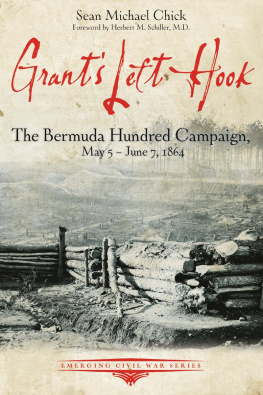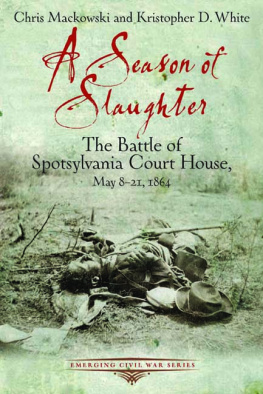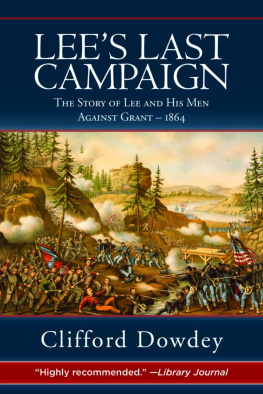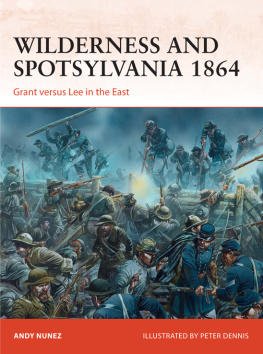If It Takes All Summer
1988 The University of North Carolina Press
All rights reserved
Manufactured in the United States of America
The paper in this book meets the guidelines for permanence and durability of the Committee on Production Guidelines for Book Longevity of the Council on Library Resources.
99 98 97 96 95 7 6 5 4 3
Library of Congress Cataloging-in-Publication Data
Matter, William D.
If it takes all summer: the battle of Spotsylvania / by William D. Matter.
p. cm.
Bibliography: p.
Includes index.
ISBN 0-8078-1781-3 (alk. paper)
1. Spotsylvania, Battle of, 1864.1. Tide.
E476.52.M38 1988 87-31950
973-736dc19 CIP
THIS BOOK WAS DIGITALLY PRINTED.
TO MY PARENTS
Lawson and Elizabeth Matter
CONTENTS
MAPS
1-1. Area of Operations, ca. 1864
1-2. Infantry Positions in the Wilderness at 5:00 A.M. on 7 May
2-1. Federal Planning Map
3-1. Area of Cavalry Operations on 7 May
4-1. Routes of March of the Federal Fifth Corps and the Confederate First Corps on the Night of 78 May
5-1. Routes of March of the Federal Sixth, Ninth, and Second Corps and the Confederate Second and Third Corps on the Night of 78 May
6-1. Federal Attack of 8 May Beginning at 6:006:30 P .M. and Ending after Dark
7-1. Route of March of the Federal Ninth Corps on 9 May
7-2. Confederate Works in the Salient, 911 May
7-3. Federal Fifth Corps and Confederate First Corps Positions on 9 May
9-1. Area of Operations, 10 May
10-1. Operations South of the Po River and at Laurel Hill on 10 May, Noon to 8:00 P.M.
11-1. Motts and Uptons Attacks on 10 May, 5:007:30 P.M.
13-1. Federal Second Corps Assault on 12 May, 4:455:15 A.M.
13-2. Initial Confederate Reaction to the Breakthrough, 12 May, 4:457:00 A.M.
14-1. Reinforcements to the Salient Front, 12 May, 6:30 A.M. to Noon
15-1. Operations Southeast of the Salient, 12 May, 2:004:00 P.M.
17-1. Federal Fifth and Sixth Corps Routes of March to the Fredericksburg Road on the Night of 1314 May
17-2. Area to the Southeast of Spotsylvania Court House
18-1. Federal Assault of 18 May, 4:309:00 A.M.
19-1. EwelPs Reconnaissance Route of March and the Engagement at Harriss Farm, 19 May, 2:008:30 P.M.
19-2. Routes of Departure
ILLUSTRATIONS
Intersection of Orange Turnpike and Germanna Plank Road /
Segment of the Brock Road /
Todds Tavern /
Spotsylvania Court House /
James Breathed /
Ulysses S. Grant /
George G. Meade /
Winfield S. Hancock/
Gouverneur K. Warren /
John Sedgwick /
Horatio G. Wright /
Ambrose E. Burnside /
Philip H. Sheridan/118 Robert E. Lee/
Richard H. Anderson /
Richard S. Ewell /
Jubal A. Early/
J. E.B. Stuart/123 McCoull house /
Harrison house and
outbuildings/
Confederate defensive works at Spotsylvania/
Confederate abatis /
James A. Beaver /
Edward (Allegheny) Johnson /
Nathaniel Church /
Joseph N. Brown /
Oliver Edwards /
Revisiting the scene of battle, 12 May 1887/
PREFACE
This work is an account of the tactical military operations conducted in the vicinity of Spotsylvania Court House, Virginia, between May seventh and May twenty-first, 1864. These operations were the second in a series of confrontations between Union and Confederate forces north of Richmond during the initial phase of the 1864 campaign in Virginia.
Following these actions the armies continued to march and fight their way southward, crossing the James River, and confronting each other by mid-June near Petersburg, where siege operations were initiated by the Federals. It is hoped that someone will provide an account of the operations between Spotsylvania and Petersburg.
Using material from official reports and correspondence and other published and unpublished sources, I have attempted to present an account that is as complete as possible. Much of the source material proved to be vague, incomplete, conflicting, or unreliable. For example, Federal battle reports were written three, four, or five months after the event, with much marching and fighting occurring between. Many of the officers who would have submitted these accounts had become casualties in the interim, and the information was composed by surviving junior officers. Most of the few surviving official Confederate reports were composed after 1864. As a result, there are blank spots in the picture. Such usually identifiable factors as times or routes of march remain mysteries in some cases. Thus, I have been obliged to revert occasionally to conjecture, but I inform the reader when doing so. Such words as possibly, probably, and approximately appear often. I regret their use but believe that the alternatives of omitting episodes from the narrative altogether because of the dearth of precise information or of boldly presenting the interpretation of an event as being factual without mentioning the uncertainty involved are less satisfactory.
This work does not address such questions as, for example, whether or not Ulysses S. Grant should be considered a heads down frontal-attack general who relied upon attrition to defeat his opponents. I believe that, before addressing such issues, one should completely understand not only the decisions made back at the headquarters tents but also the conditions in the front lines and the details of the fighting there. This work, it is hoped, will supply some of this information for a two-week period in May 1864.
I hope that the narrative will enhance the readers appreciation of the devotion to duty and personal courage exhibited by the American soldier, North and South, during the nations Civil War. Generals are awarded praise and promotion, but not without enlisted men.
ACKNOWLEDGMENTS
One of the major benefits derived from performing a work such as this is that one becomes acquainted with many fine people while searching for information. Most of these people work in libraries or historical societies. Without their expertise and assistance very little could be accomplished by researchers. This inadequate acknowledgment cannot begin to repay the debt which I owe to each of them.
I particularly wish to record my gratitude to the following individuals. From the National Park Service: Robert K. Krick, Chief Historian, James H. Ogden III, Park Historian, and the late David A. Lilley of the Fredericksburg and Spotsylvania National Military Park; Edmund Raus of Manassas National Battlefield Park; Christopher M. Calkins of Petersburg National Battlefield Park; Kathleen R. Harrison, Research Historian at Gettysburg National Military Park.
From the United States Army Military History Institute: Dr. Richard J. Sommers, Archivist of Manuscripts, and his competent staff. Dr. Sommers shared his vast knowledge and expertise concerning Civil War matters and suggested valuable sources of information; Norma Umbrell of the library staff; Michael J. Winey, Curator.
In addition, I owe thanks to Diane C. Ansley, Office of the Registrar, National Museum of American History, Smithsonian Institution, who kindly furnished information pertaining to the oak tree stump on display at the Smithsonian; Dr. Gerald S. Brinton of New Cumberland, Pennsylvania; William C. Davis of Mechanicsburg, Pennsylvania, Civil War author and editor, for helpful advice; James A. Kegel of Mechanicsburg; Charles J. Kelly, Gary J. Kohn, and Marianne Roos of the Manuscript Division, Library of Congress; Loni Lindeman of Gettysburg, Pennsylvania; Patricia Morris of St. Augustine, Florida, and Ruth E. Potter of Harrisburg, Pennsylvania, who typed the manuscript; Michael P. Musick, Military Records Division of the National Archives, for his many favors and assistance; Edwin H. Olmstead of Mount Holly Springs, Pennsylvania; Jeanette C. Parson, Pattee Library, Pennsylvania State University; Richard A. Saurers, of Harrisburg, who provided leads to many obscure sources; Bryce A. Suderow, of Cotati, California, who made available applicable portions of his study of Confederate casualties; Charles and Rosemary Walker of Woodstock, Virginia, for their warm hospitality and assistance. Finally my gratitude to Agnes V. McGee of Bloomsbury Farm, Virginia, for kindly permitting repeated access onto her property, which is the site of the Harris farm.





